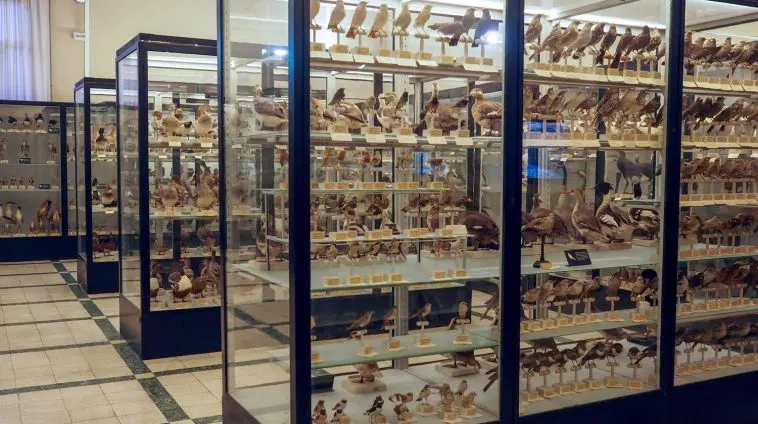[Originally published as Specie. Naming, Grouping, and Defining]
Specie is a fundamental concept in modern biological evolution—it is the building block of Earth’s vast and diverse biosphere. Explaining the origin of species formed the foundation of Charles Darwin’s bestseller — On the Origin of Species by Means of Natural Selection
One of biology’s principal functions is naming, grouping, and defining of species. Exploring the history of the term opens a fascinating window into the checkered history of Darwin’s theory of natural selection. The term is a Latin word meaning “a particular sort, kind, or type.” The word originated from the Indo-European term spek, meaning ‘to observe,’ the language of Japheth, one of Noah’s three sons.
Understanding earth’s biosphere, populated with diverse life forms known as species, is a principle function of biology independent of the theory of evolution. The process of naming these life forms, beginning in Genesis, would seem straightforward, but it hasn’t and isn’t.
Species Naming
A species name is intended to be like a calling card, conveying the species’ character. The commonly known Lionfish was first named by German naturalist Lorenz Oken in 1817. The name In French, “Les Pterois,” means “fins,” referring to its high dorsal and long pectoral fins. Simple enough.
However, determining what characteristics distinguish one species from another has long challenged naturalists. As Charles Darwin explained in The Origin of Species –
It is all-important to remember that naturalists have no golden rule by which to distinguish species and varieties.
During the fifteenth-century Age of Discovery, naturalists collected, cataloged, and managed an explosion of unknown life forms. From these global expeditions, the field of Modern Biology emerged. However, as science writer Mindy Weisberger in the CNN article “What defines a species?” (2023) notes:
“Biologists have wrestled with the concept [species] for about as long as the field of biology has existed.”
Early Western Civilization approaches focused on naming based on each life form’s unique distinctiveness.
John Ray (1627–1705), the founder of modern biology, coined the term “species” to distinguish between the diverse types of plants and animals. Elected as a Fellow of the Royal Society, he noted in 1686:
No surer criterion for determining species has occurred to me than the distinguishing features that perpetuate themselves in propagation… Animals likewise that differ specifically preserve their distinct species… one species never springs from the seed of another nor vice versa.
Ray published over 170 works. In his three-volume Historia Plantarum, published between 1886 and 1704, more than 8,000 plant species were named and grouped. In his honor, the Natural History Museum in London founded the Ray Society, a scientific text publication society, in 1844.
A young Swede would reignite Ray’s pursuit by viewing earth’s biosphere as an orderly system.
Carolus Linnaeus
The Swedish naturalist Carolus Linnaeus (1707–1778) continued naming plants and animals but with a new method. Linnaeus introduced an innovative binomial — two-naming — system using observable similarities. In Species Plantarum, originally published in 1753, Linnaeus perceived an order in creation:
“The study of nature would reveal the Divine order of God’s creation, and it was the naturalist’s task to construct a ‘natural Classification’ that would reveal this order in the universe.”
Linnaeus published more than thirty works during his lifetime. The best-known is Systema Naturae, a twelve-page work first printed in the Netherlands in 1735.
By the time Systema Naturae reached its 2,400-page tenth edition in 1758, Linnaeus had included 7,700 species of plants and 4,400 species of animals. Like Ray, Linnaeus contested the Greek concept of “spontaneous generation,” noting:
All the species recognized by Botanists came forth from the Almighty Creator’s hand, and the number of these is now and always will be exactly the same… Accordingly, to the former have been assigned by Nature fixed limits, beyond which they cannot go: while the latter display without end the infinite sport of Nature.
The binomial system consists of a generic name and a specific name, the method still used in modern biology. The system is also known as the species binomen, scientific name, or Latin name.
Greek Philosophy Influence
The foundations for many Western academic traditions emerged from the influences of ancient Greek philosophy. Even today, fraternities (fraternities) and sororities (sororities) are collectively referred to as Greek Life.
While subscribing to a biblical worldview, Linnaeus’s naming approach included Greek influences that were likely introduced at Swedish universities. In Genesis, plants and animals are grouped for practical reasons, like health and safety. However, differing from Genesis, the Greeks grouped species to reflect an order in earth’s vast biosphere.
The very title of title of Linnaeus’ major work demonstrates this influence. Systema implies that things work together as parts of a mechanism or an interconnecting network. Naturae originates from Latin nātūra, a philosophical term derived from the verb for birth, a translation for the (pre-Socratic) Greek term phusis, defined as to grow, to appear.
Aristotle (384–322 BCE), the tutor of Alexander the Great, introduced the concepts of natural philosophy into Western academia. Natural philosophy emerged as the dominant study approach in biology.
Species Grouping
Swiss botanist Augustin de Candolle (1778–1841) was the first to continue Linnaeus’s naming work, publishing Theories Elementary de la Botanique (1813). Influenced by the Greek understanding of nature, de Candolle grouped species based on observable similarities.
After arriving in Paris in 1798, de Candolle befriended Jean-Baptiste Lamarck, preparing revisions of his Flore française (1805–1815) using Aristotle’s approach.
De Candolle introduced the term taxonomy. In Greek, taxis means arrangement, and nomos means rules or law. Taxonomic grouping is a practical application of Linnaeus’ approach. By 1831, Darwin was corresponding with de Candolle.
Charles Darwin
In The Origin of Species, Darwin referred to de Candolle more than twenty times. Like de Candolle, without any specific evidence, Darwin speculated that the Galapagos finches’ similarities served as evidence of an evolutionary process, arguing:
Seeing this gradation and diversity of structure in one small, intimately related group of birds, one might really fancy that from an original paucity of birds in this archipelago; one species had been taken and modified for different ends.
Like de Candolle, however, Darwin never defined “species.” The practice of not defining terms was in vogue during the Age of Enlightenment and even encouraged. Defined terms were thought to restrict enlightenment thinking.
While this approach is an acceptable practice in philosophy, undefined terms in science are not acceptable. Not surprisingly, Darwin never defined the key term in the title of his book, species, noting:
“It is not pretended that we have any sure criterion by which species and varieties can be discriminated.”
This practice has since contributed to the emergence of Darwin’s species problem. The Enlightenment movement clashed with the Scientific Revolution. Not surprisingly, the Royal Society never recognized Darwin’s works following the publication of The Origin of Species in 1859.
Species Naming Consensus
To address emerging issues, the first annual International Botanical Congress (IBC) met in Brussels in 1864 to standardize botanical nomenclature. Three years later, they published the “Best Guide to Follow for Botanical Nomenclature” in Paris.
However, a lack of universal consensus on the definition of species continued into the twentieth century; WIKIPEDIA explains the source of the problem:
Although intended as an objective method, in practice the choice and implicit or explicit weighting of characteristics [similarities] is influenced by available data and research interests of the investigator.
Even objective methods are not exempt from subjective influences. By the mid-twentieth century, a new definition of species based on Ray’s earlier reproductive concept was presented in his History of Plants (1686) publication:
“…no surer criterion for determining species has occurred to me than the distinguishing features that perpetuate themselves in propagation from seed. Thus, no matter what variations occur in the individuals or the species if they spring from the seed of one and the same plant, they are accidental variations and not such as to distinguish a species… Animals likewise that differ specifically preserve their distinct species permanently; one species never springs from the seed of another nor vice versa.”
Modern Definition
English evolutionary biologist Ernst Mayr (1904–2005) proposed reproductive isolation (RI) as an option for Darwin’s “golden rule,” noting:
Species are groups of actually or potentially interbreeding natural populations, which are reproductively isolated from other such groups.
As one of the most popular authors in this competitive field, Mayr was pivotal in establishing a broadly accepted definition of species. In Systematics and the Origin of Species (1942), Mayr presented his biological species concept (BSC), a seeming resolve to the species definition problem.
Mayr emerged as a leader in the “species problem” debate. As Anja Westram explains in “What is Reproductive Isolation?” published in the Journal of Evolutionary Biology (2022):
“Reproductive isolation (RI) is a core concept in evolutionary biology and the basis by which biological species [BSC] are defined.”
Consensus
Mayr’s species concept resonated with evolution scientists, including Theodosius Dobzhansky. In Genetics and the Origin of Species (1937), Dobzhansky subscribed to Ray’s and Mayr’s RI concept.
Julian Huxley, the grandson of Darwin’s Bulldog, synthesized the concepts developed by Mayr and Dobzhansky, along with those proposed by George Gaylord Simpson and George Ledyard Stebbins in his book, Evolution: The Modern Synthesis (1942).
Huxley’s synthesis of natural selection, Mendelian genetics, and population genetics emerged as a dominant biological paradigm, unleashing a revolution in research and biotechnology, prompting Dobzhansky to declare:
Nothing in biology makes sense except in the light of evolution.
By the mid-twentieth century, evolution scientists finally had the tools to study evolution scientifically, armed with a universal definition of species and a mechanism to drive evolution.
Definition Testing
Huxley’s theory emerged as the most widely recognized theory of evolution. However, the expanding reach of late-twentieth-century biotechnology soon tested Mayr’s RI concept. Westram explains further:
A key conclusion is that RI depends strongly on circumstances—including the spatial, temporal, and genomic context — making it difficult to compare across systems. After reviewing methods for estimating RI from data, we conclude that it is difficult to measure in practice.
Biologists soon reignited the search for a universal and testable species concept. One of the first papers emerged in 1970 by Robert Sokal and Theodore Crovello, arguing for a return to a similarities [phenetic] species concept — unleashing a new round of defining species papers. A flood of definitions followed.
Test Results
By 1997, Biologist Richard Mayden of St. Louis University identified twenty-four proposed species definitions. Philosopher of biology John Walkins of the University of Sydney published “A List of 26 Species ‘Concepts’” in 2006. According to the Smithsonian Magazine (2013):
“More than 70 official species definitions exist, of which 48 are widely accepted and used by scientists.”
Matthias Wolf, Chair of Bioinformatics at the University of Würzburg, outlines the issues surrounding the definition of species in the article “How to Teach about What Is a Species?” (2021) published in the journal Biology, concluded:
The discussion about what a species is will certainly continue.
Genomic Revolution
Of the new lines of technical evidence available to distinguish between species, the entry of the genomic revolution was anticipated to uncover the elusive “golden rule.” However, as Nancy Simmons, curator-in-charge of mammalogy at the American Museum of Natural History, explained to Weisberger:
“We get into questions of how much of a percentage of a difference in the genetic code do you have to be a distinct species — and people disagree on that, too… So, even when we have genetic data, you don’t find complete agreement about how to interpret it.”
Lacking an “agreement” on defining a species makes studying evolution tricky. As zoologist, Kevin de Queiroz of the Smithsonian Institution explains in the article “Ernst Mayr and the Modern Concept of Species:”
Despite the important influence that Mayr’s writings concerning species had on systematics in particular, and on evolutionary biology in general, and despite the wide adoption of his proposed species definition in textbooks, these contributions did not solve the long-standing problem concerning the nature of species.
Current Species Status
Species are the building blocks of earth’s biosphere. Without a definition of species, identifying what constitutes the emergence of a new species is beyond the reach of science. The problem of finding Darwin’s missing “golden rule” is as old as biology itself. As even Dobzhansky reportedly noted in 1937:
“Of late, the futility of attempts to find a universally valid criterion for distinguishing species has come to be fairly generally, if reluctantly, recognized.”
In the Quanta magazine article, “A Mutation Turned Ants Into Parasites in One Generation” (2023), science writer Viviane Allier mirrored Dobzhansky’s observations:
How exactly a speciation event could happen after the parasitic phenotype arises is a mystery… however, that all these questions and speculations are complicated by the slipperiness of defining what a species is.
After centuries of accumulated thought and wisdom, clarity about defining what constitutes a species is still a work in progress. To date, a consensus on defining a species continues to elude every professional science organization.
New Big Mountain
Currently, the number of named species is exceedingly dwarfed by the number of unnamed species. In 2022, the International Union for Conservation of Nature (IUCN) listed the names of just 2.16 million living species. However, as Robert May, a mathematical biology legend, estimates in a paper published in Science (2010):
“Our best guess [is]… in the range of 5 to 10 million eukaryotes (never mind the viruses and bacteria), but we could defend numbers exceeding 100 million, or as low as 3 million.”
The magnitude of the task paints a daunting new mountain for biology to climb. As Kevin Thiele, in the Smithsonian article, “Why Scientists Name Species,” notes:
At our current rate of progress, it will take more than 400 years even to approach a complete biodiversity inventory of Australia.
To continue the process of naming species, new nomenclature organizations have been formed. While naming is an essential function of biology, without it, as The Harvard Gazette notes –
“A rose by any other name — could be confusing.”
Defining a species continues to be one of the top debated and challenging issues in biology. Defined terms are a prerequisite to developing testable theories of evolution.
Genesis
The concept of species is compatible with Moses’s Genesis account. Each “kind” is a distinctly uniquely stable entity, as envisioned by John Ray, the founder of modern biology.
Until recently, the scope of establishing a universal definition of species seemed within the reach of science. However, John Ray seemed to have early insights into the magnitude of Earth’s biosphere, writing:
If the number of the creatures be so exceedingly great, how great, nay, immense, must needs be the power and wisdom of him who formed them all! For… as it argues and manifests more skill by far in an artificer, to be able to frame both clocks and watches, and pumps and mills, and grandiose and rockets, than he could display in making but one of those sorts of engines; so the Almighty discovers more of his wisdom in forming such a vast multitude of different sorts of creatures, and all with admirable and irrevocable art, than if he had created a few; for this declares the greatness and unbounded capacity of his understanding.
Developing a scientific consensus on the mechanisms of evolution still remains speculative.







